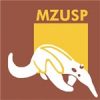The termite collection has about 27,500 listed samples. In this collection there are 82 holotypes, one neotype, three lots of synotypes, and 124 lots of paratypes. About 3000 lots are awaiting registration to be included in the collection. Most samples are kept in 80% alcohol. However, there is already a reasonable amount of material fixed in alcohol 96%, providing studies with molecular data that are being performed by this laboratory’s team.
Entomology
Isoptera – Termites and other Ortopteroids
History
The Isoptera collection of the Museu de Zoologia of USP (MZUSP) is considered the most important in Brazil. It began in the 1940s with the efforts of Renato L. Araújo, who died in 1978. Since then, it has continued to grow, with the projects of the curator, Dr. Eliana Marques Cancello and her students, in addition to the collaboration of leading Brazilian specialists and some colleagues from various parts of the world.
The collection is one of the best in the world in terms of the Neotropical Region’s representation, although it is not the repository of most types of Neotropical species. It has samples of all the described genres from this region, plus all those from the Palearctic and Nearctic regions, as well as some material from the Eastern, Australian, and Ethiopian regions. All Brazilian biomes are represented, but not uniformly.
The expressive growth of the collection is also due to several FAPESP grants, the most important being the Biota/Fapesp project “Wealth and Diversity of Hymenoptera and Isoptera along a Latitudinal Gradient in the Atlantic Forest” (1999-2005). In recent years, it is also worth mentioning the surveys in the areas of the Hydroelectric Power Plants (HPPs) of Jirau and Santo Antônio, in Rondônia, in the region of the upper Madeira River, carried out between 2010 and 2012, the doctoral degree dissertation of Tiago F. Carrijo and Tarik Godoy Dangl Plaza and the master’s degree thesis of Rafaella G. Santos. From these locations were included in the collection 6179 samples, plus abundant material not listed, which can be used for exchanges, for example.
Another recent increment for the reorganization of the collection was the presence of higher-level technical improvement fellows within the project “Contribution to the Taxonomy of Termitidae (Insecta: Isoptera) and orthopteroids’ curatorship of the collection of the Museu de Zoologia of USP (MZUSP)”, approved in the Call for Applications CNPq/Protax- Taxonomy Training Program (November 2010 to November 2010). (2014, Proc. 562256/2010-5).
The data from the samples listed in the collection were all included in a computerized database – the Specify software Project. Until October 2019 there were 27475 samples registered, plus about 3000 to be processed and about 4000 in ethanol 96% for DNA extraction. Field data, such as notes on collection sites, or on the nests, tenants (other species of termites and/or several arthropods found together in the same nest), and photos are also being included in this bank, which should be available soon. All this effort was part of a national project, the Brazilian Biodiversity Information System (SIBBR), which financed the payment of scholarship holders and equipment (computers) for collection computerization tasks.
Conditioned in compactor cabinets, the collection is kept in excellent condition by the MZUSP team’s technicians, in addition to eventual scholarship holders, such as those mentioned above, who assist in the basic services of technical curatorship, always with the curator’s supervision.
There is also a concern to expand the coverage of this collection with samples from other regions of the world.
Phasmatodea Collection
The MZUSP’s Phasmatodea collection has approximately 1,200 specimens preserved in dry, including 11 holotypes, 4 synotypes and 3 paratypes. The collection has representatives of all five families of stick insects that occur in Brazil (Diapheromeridae, Heteronemiidae, Phasmatidae, Prisopodidae and Pseudophasmatidae), as well as a small number of representatives of the Agathemeridae, Aschiphasmatidae, and Lonchodidae families. Ninety percent of the collection is identified up to the gender level, with at least 48 genders represented.
Besides adults and nymphs, the collection also has an assemblage of eggs, whose preservation is important for taxonomic studies in Phasmatodea. Currently, 80 lots of eggs are available, belonging to at least 45 species distributed in 16 genera and 4 families.
The Phasmatodea’s collection underwent significant growth between 2015 and 2019, mainly because of Pedro Ivo C. Machado’s doctoral degree project, “Taxonomic review and phylogenetic analysis of Paraphasma (Phasmatodea: Pseudophasmatidae: Stratocleinae)” (FAPESP process 2015/08808-2). The curatorship activities related to this project also made it possible to better organize the collection, making it more conducive to other taxonomic studies.
Mantodea Collection
The Mantodea’s collection was the publication subject of laboratory members:
Rodrigues, H.M. & Cancello, E.M. 2013. Mantodea (Insecta) collection in the Museu de Zoologia da Universidade de São Paulo: Taxonomic and geographical coverage
Check List 9(5): 957–965.
Faculty Curator
Systematics and Biology of Isoptera; patterns of distribution and diversity of termites of the Neotropical Region
Prof. Dr. Eliana Marques Cancello
Phone:
+55 (11) 20658137 (office)
+ 55 (11) 2065 81 34 (students)
E-mail : ecancell@usp.br
Online Collection
Technical Support
Ana Maria Vasques (Research and Museum Support Specialist)
Phone: (55) (11) 2065-6685
E-mail: vasques@usp.br
Carlos Campaner (Research and Museum Support Specialist)
Phone: (55) (11) 2065-8125
E-mail: campaner@usp.br
Joel Alves da Conceição (Museum Assistant)
Phone (55) (11) 2065-8139
E-mail: joelcon@usp.br
Thalita Fonseca Alves (Museum Technician)
Phone: (55) (11) 2065-8139
E-mail: tha.fonseca@usp.br
